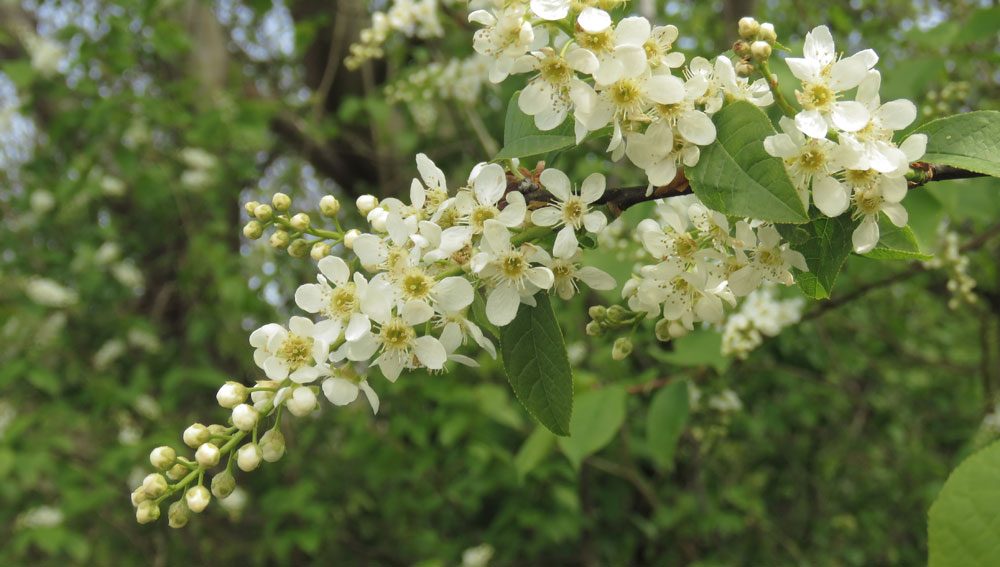As summer brings heat it also brings us some great foraging opportunities. Wild Cherry and Mint are ready to be harvested. They are readily available and will add a great freshness to our summer. Let’s go foraging!
Wild Cherry

The Prunus genus contains a variety of species often referred to as Wild Cherry Trees. Native and the most common in North America are the Chokecherry (Prunus virginiana) and the Black Cherry (Prunus serotina)
Identification
Wild cherry trees are found growing just about anywhere from open fields to open woods. The bark of wild cherry trees is smooth with horizontal lenticels. These horizontal stripes are rough and often reddish-brown. Leaves are dark green and glossy have finely serrated edges. The blooms are white five-petaled flowers that produce a red fruit that darkens to a dark purple when ripe.
Many trees in the Prunus genus often have cankers or burls due to a fungus often called black knot. While not always present, the black knot fungus is a helpful identification mark of wild cherry trees.
Harvesting and storing
The fleshy fruit is the only part of the wild cherry that is edible. Cherries can be harvested when they ripen in the summer between May and July. Pluck ripe dark berries off the tree by hand. Sample a few as you harvest as the taste, bitterness, and sweetness can vary from tree to tree.
Since the fruit is small with large pits, we may need more fruit than expected. Gather as many as are ripe. Cherries are perennials and great self-seeders so do not be concerned about taking too many.
To preserve freshness, store harvested cherries in an airtight container in the refrigerator.
Health benefits
Cherries are high in antioxidants such as chlorogenic acid, quercetin, and kaempferol. These antioxidants have been shown to help reduce arthritis and pain from gout. Cherries are also a great source of B-vitamins, potassium, and fiber.
Use
Wild cherries can vary in taste. They can range for very bitter to very sweet, but most will have a small hint of bitterness. Cherries can be eaten raw or taken home and cooked down into a sauce to go with meat, can provide a nice flavor for a punch, or made into a jam. Cherries can even be chopped and added to burgers to increase flavor and juiciness.
Make sure to take the pits out. Personally, I can tell you that unexpectedly biting into a pit is not a pleasant experience.
Cherry wood can add a nice flavor when grilling or smoking meats. Just a few branches and twigs will go a long way. Trimming off a few dead or non-fruit bearing branches will liven up our next barbecue.
Caution
Only the fleshy fruits are edible. All other parts of the cherry tree including leaves, bark, and seeds contain hydrogen cyanide. Yes, cyanide! If consumed hydrogen cyanide breaks down into cyanide in humans. Hydrogen cyanide provides a warning with a very bitter taste. So if sampling berries and they have a strong bitter taste, it is best to avoid them.
Wild Cherry Venison Burgers Recipe:
Mint

Mint is a common and popular herb. The mint used in restaurants and found among herbs at the grocery store is most likely native to Europe and Asia. But we can forage the Native American Wild Mint (Mentha Canadensis) in America and it is just as good! Non-native varieties are often found as they naturalize and spread. Mint is often planted and as its rhizomes spread underground new mint shoots will sprout up around the original plant.
Mint is an aromatic perennial with leaves that have been used for centuries to flavor beverages, sauces, and a variety of food. The glands contain essential oils that are extracted to provide a variety of uses.
Soil and Sun
Mint prefers a moist to wet soil with partial shade. While cultivated varieties of mint often grow in the wild, look for American Wild Mint thriving in open areas and low fields near lakes, rivers, and marshes. Mint, like many plants, seems to also grow around old homesteads. This is believed to be due to its perennial nature and that many farmers planted mint to be used for home remedies and flavoring.
Identification
The easiest way to identify mint is a strong minty aroma. Walking downwind of some mint can lead us to the source. When investigating a potential mint plant, crushing a few leaves will reveal an aroma to confirm.
Physically the mint family has a square stem with opposite leaves. Mint blooms range from white to purple in color.
Harvesting and Storing Mint
Mint is hardy and can be harvested all summer long by clipping the plant about an inch above the ground. As with most harvesting, it is best to only take what you need. Mint is very hardy but collecting a few handfuls at a time will improve the health and longevity of the plant. Once we have found a good patch we can return all summer long for a handful as needed. Any extra can be stored for use later. As the cooler weather moves in mint will go dormant. Before it goes dormant gather a few handfuls to use during the winter months.
Two common ways to store mint is to chop fresh mint and then freeze in ice. Once frozen the cubes can be stored in the freezer to be thawed and used as needed. The second method is to tie a bundle of mint together and let hang upside down to dry. Once they have dried, strip the leaves and store in a mason jar.
Health Benefits
Mint has been studied and used for its great health benefits. Mint has one of the highest antioxidant and anti-inflammatory capacities known. Containing rosmarinic acid that studies show to be effective in relieving allergy symptoms. Rosmarinic acid has antioxidant and anti-inflammatory properties that give mint its medicinal properties. Over the years, mint has been used to calm upset stomachs and soothe sore throats. It can also provide a pleasing pleasant fragrance all year long.
Use
Tossing a few chopped leaves and slices of cucumber into our water will provide us a refreshing kick without any added calories. But a common and simple use of mint is to make a tea. Pour two cups of water over a handful of mint leaves. Allow it to steep for a few minutes gently stirring occasionally. Add a dab of honey and we have a delicious and soothing warm cup of tea that we can breathe in and sip. Cocoa can be added to the mix for minty hot cocoa.
Mint can be used in homemade jellies and jams. The leaves can be crushed and added to a salve that can be applied to calm and cool insect bites.
Caution
Mint has countless benefits, but the fruit of the mint plant can be fatal in large quantities. Sometimes mistaken as a grape, the fruit can be very dangerous to children.



























